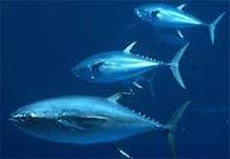
Mackerel is a common name applied to a number of different species of pelagic fish, mostly from the family Scombridae. They are found in both temperate and tropical seas, mostly living along the coast or offshore in the oceanic environment.

The mackerel, tuna, and bonito family, Scombridae, includes many of the most important and familiar food fishes. The family consists of 51 species in 15 genera and two subfamilies. All species are in the subfamily Scombrinae, except the butterfly kingfish, which is the sole member of subfamily Gasterochismatinae.

The Atlantic mackerel, also known as Boston mackerel, Norwegian mackerel, Scottish mackerel or just mackerel, is a species of mackerel found in the temperate waters of the Mediterranean Sea, the Black Sea, and the northern Atlantic Ocean, where it is extremely common and occurs in huge shoals in the epipelagic zone down to about 200 m (660 ft). It spends the warmer months close to shore and near the ocean surface, appearing along the coast in spring and departing with the arrival of colder weather in the fall and winter months. During the fall and winter, it migrates out into deeper and more southern water, seeking warmer temperatures.

The Carangidae are a family of ray-finned fish that includes the jacks, pompanos, jack mackerels, runners, trevallies, and scads. It is the largest of the six families included within the order Carangiformes. Some authorities classify it as the only family within that order but molecular and anatomical studies indicate that there is a close relationship between this family and the five former Perciform families which make up the Carangiformes.

The chub mackerel, Pacific mackerel, or Pacific chub mackerel is a species of fish in the tuna and mackerel family, Scombridae. This species of mackerel closely resembles the Atlantic chub mackerel.

Archaeus is an extinct genus of marine jackfish from the Paleogene of Europe, where it inhabited the former Tethys Ocean. The oldest species, A. oblongus is from the early Ypresian epoch of Eocene Turkmenistan, and the last species, A. glarisianus and A. solus, are from the early to middle Rupelian, of the Oligocene lagerstatten of Canton Glarus, Switzerland and the Pshekha Formation of North Caucasus, Russia.

The blue mackerel, also called Japanese mackerel, Pacific mackerel, slimy mackerel or spotted chub mackerel, is a fish of the family Scombridae. It typically reaches 30 cm (12 in) in length and 1.4 kg (3.1 lb) in weight.

The Gempylidae are a family of scombriform ray-finned fishes commonly known as snake mackerels or escolars. The family includes about 25 species.

Crestfishes, family Lophotidae, are lampriform fishes found in most oceans. It consists of two extant and four extinct genera.

Scomberomorus is a genus of ray-finned bony fish in the mackerel family, Scombridae. More specifically, it is a member of the tribe Scomberomorini, commonly known as the Spanish mackerels.

Caranx is a genus of tropical to subtropical marine fishes in the jack family Carangidae, commonly known as jacks, trevallies and kingfishes. They are moderate- to large-sized, deep-bodied fishes which are distinguished from other carangid genera by specific gill raker, fin ray and dentition characteristics. The genus is represented in the Pacific, Indian and Atlantic Oceans, inhabiting both inshore and offshore regions, ranging from estuaries and bays to deep reefs and offshore islands. All species are powerful predators, taking a variety of fish, crustaceans and cephalopods, while they in turn are prey to larger pelagic fishes and sharks. A number of fish in the genus have a reputation as powerful gamefish and are highly sought by anglers. They often make up high amounts of the catch in various fisheries, but are generally considered poor to fair table fishes.

Euzaphlegidae is a family of extinct escolar-like ray-finned fish closely related to the snake mackerels. Fossils of euzaphlegids are found from Paleocene to Late Miocene-aged marine strata of Europe, the Caucasus Mountains, India, Iran, Turkmenistan, Italy, and Southern California.

Palimphyes is an extinct genus of marine ray-finned fish known from the Paleogene period. It was a euzaphlegid, an extinct family of scombroid fish related to the escolars and snake mackerels.

Rastrelliger is a mackerel genus in the family Scombridae. The three species of Rastrelliger together with the four species of Scomber comprise the tribe Scombrini, known as the "true mackerels".

The Scombrinae are a subfamily of ray-finned bony fishes in the family Scombridae. Of the 51 species in the Scombridae, 50 are in Scombrinae – with the sole exception being the butterfly kingfish, which is placed in the monospecific subfamily Gasterochismatinae.

Scombrini, commonly called the true mackerels, is a tribe of ray-finned bony fishes in the mackerel family, Scombridae – a family it shares with the Spanish mackerel, tuna and bonito tribes, plus the butterfly kingfish.
Scomber indicus or Indian chub mackerel is a species of fish in the family Scombridae found in the coast of Kerala, India.
Ozymandias gilberti is a species of extinct ray-finned fish from the Miocene which was described by David Starr Jordan in 1907 from a single specimen, comprising the skull and some vertebrae, discovered from San Pedro, California. It is thought to be a species of large mackerel or tuna in the family Scombridae. Jordan initially assigned another fossil to this species but changed his mind and assigned the second fossil to the living Cottoid genus Ophiodon, the lingcod, as Ophiodon ozymandias. The specific name honours the discoverer of the fossil Dr James Z. Gilbert.
















